|
|
“Winding
up on the Poor Farm,” wasn’t just an expression or an idle phrase
used to describe a bad business venture a long time ago. Poor Farms,
poor houses or almshouses, are not a figment of your parent's, grandparent’s,
or your great-grandparent’s imaginations. They were a very real place,
of which one did not want to be forced to go to as a result of economic
failures and hard times.
Though the poor farm is no longer a part of our modern society, the
history of the institution should not be overlooked. The history of
the poor farm provides insight into the development of the state’s
public welfare system and its overall attitude toward federal relief.
The existence of the poor farm in Texas
is part of a larger national story that shows how nineteenth and twentieth
century America responded to the needs of its indigents for almost
100 years. |
Building
at The Anderson County Poor Farm
Photo by Dana Goolsby,
2011 |
Poor Farms are
defined by the American Heritage Dictionary as, "A farm that houses,
supports, and employs the poor at the public's expense.” Poor Farms
were the predecessor to modern day welfare, and society’s dumping
grounds for outcasts. Those who were insane, tubercular, deaf, imbecile,
criminal, aged, or poor were often placed together on county poor
farms. They were viewed as hopeless and useless.
Prior to the Great Depression, America’s poor were handled within
a system that evolved from seventeenth century English poor laws,
and generally provided minimal relief and involved limited government
services. American colonist transplanted Elizabethan England methods
of care for the poor, and emphasized poverty as disgraceful and provided
relief strictly to avoid disorder.
Texas poor farms operated quietly, with little to no interaction with
the public. They were established to deal efficiently with growing
problem, but were never considered governmental institutions of importance.
Poor farm inhabitants were seen as destitute outcasts. Today the history
of Texas’ poor farms is greatly overshadowed by the establishment
of New Deal relief agencies and the ultimate welfare revolution.
The
first mention of a county poor farm in Texas
can be found in within the 1869 constitution. Article XII, sections
26 reads, “Each county in the State shall provide, in such a manner
as may be prescribed by law, a Manual Labor Poor House, for taking
care of, managing, employing, and supplying the wants of its indigent
and poor inhabitants; and under such regulations as the legislature
may direct, all persons committing petty offenses in the county may
be committed to such Manual Labor Poor House for correction and employment.”
By including that provision, the State of Texas harnessed county governments
with the direct responsibility for its poor. The provision also reinforced
to popular nationwide beliefs: 1) Care was to be based on the principle
of “less eligibility,” and 2) assistance was never intended to provide
a life as comfortable in comparison to that which non-recipients had.
In the Lone Star State, Texans who survived the frontier experience
viewed rugged individualism as a value and applauded opportunity and
success. Excessive dependence was not looked upon kindly or with sympathy.
Texas took great caution in order to avoid unwarranted assistance.
Texas, along with many other states, required poor farm inhabitants,
also known as paupers, to take an oath, and swear to their lack of
goods and their desperate need for assistance. Paupers would then
forfeit the control of their personal lives and basic rights as a
citizen, including their right to vote, and move to the poor farm.
Such extreme requirements were intended to be a deterrent for those
seeking to live on the poor farm. Only the most desperate and those
who were the least prideful inhabited the poor farms.
Poor farms have vanished due to federal relief programs, and their
rapidly fading histories have mostly been entirely forgotten. The
Texas Poor Farm has become a mythical part of our past, even though
poor houses and farms have been around for hundreds of years and some
were operating into the 1960s. Little is known today of the state’s
early attempts at government intervention during times of individual
and national crisis, and even some of the most seasoned Texans do
not recall their county’s poor farm, or for that matter, realize poor
farms existed outside of an expression. |
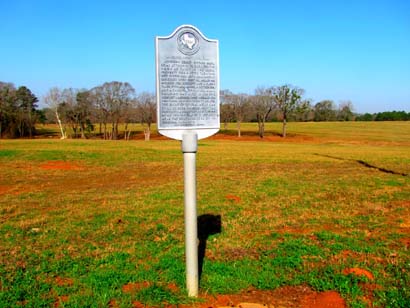 |
Anderson County
Poor Farm historical marker
Photo by Dana Goolsby,
2011 |
Few
area residents are aware that Anderson
County had a poor farm. Lifelong Anderson
County resident Carol Staples was unaware that such an institution
ever existed within the county.
“It is amazing that I have lived here all of my life and never knew
that,” Staples said.
Other area residents contribute the lack of knowledge surrounding
the poor farm to generations before them that were not forthcoming.
“Older generations just did not talk about things. Maybe they thought
they were protecting younger people, but things such as this were
not spoken of,” said another area resident.
Despite there being little remains of the institution, the poor farm
system was quite common in Texas. According
to a survey of county clerks and county historical commissions in
1987, at least 65 of Texas’ 254 counties
had some type of county-operated poor farm.
In
1861, the 15-year-old Anderson
County had encountered a problem with its poor. That year, the
Anderson County Court ordered petitioned the State Legislature to
pass an act which would authorize the County Commissioners to purchase
a tract of land in order to erect a poor house. The county specified
that the tract of land not exceed 200 acres within five miles of Palestine.
The Anderson County Court also requested that the court be authorized
to levy and collect an amount sufficient to pay for the land and necessary
building, by way of taxation.
With the War Between the States approaching, the State Legislature
and Anderson County Court put the poor house on the back burner until
the 1870s, also known as the Reconstruction Days. In 1872, the court
again petitioned the State Legislature for authorization to construct
a poor house.
February 1872, Anderson
County purchased property for an intended poor house, however,
by March of that year Presiding Justice W.T. Smith was ordered to
rent a building and furnish the paupers with food, clothing and fuel.
According to Anderson County Commissioners Court Minute Books, money
was to be withdrawn from any fund other than those set aside for road
repairs or jury service. Smith was also instructed to erect a building
on any vacant lot in Palestine
owned by the county.
That same year, R. Dowling was named as Steward over the Anderson
County Poor Farm, however, according to the Texas Historical Commission,
no records or deeds can be located which detail the arrangement made
between Dowling and the county. There are, however, multiple records
concerning the care of several indigents. According to the Anderson
County Historical Commission, there are numerous records regarding
the care of an “indigent widow,” an “indigent person,” Paupers,” and
an “indigent blind person.” Other records used only the term, “indigent.”
In Anderson County,
it appears to have been customary for one person to care for each
individual and then present the county with a bill for the rendered
care each quarter in order to receive payment. Amounts for care rendered
reportedly varied at substantial rates. For instance, one person might
receive $100 for the care of a pauper, while another might receive
$25. Due to such variations,
Anderson County eventually insisted that paupers and those representing
them must appear before the court and be verified, otherwise no appropriations
would be allowed. |
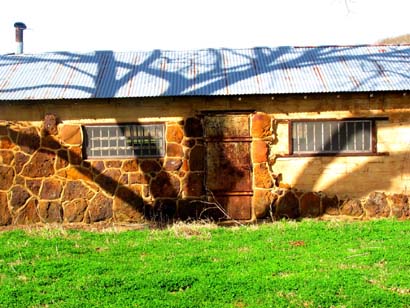 |
Anderson
County Poor Farm building
Photo by Dana Goolsby,
2011 |
Anderson
County Poor Farm historical marker
Photo by Dana Goolsby,
2011 |
A
little more than a decade later, in 1884, Anderson
County finally obtained its poor farm. The county paid $2,700
for approximately 462 acres, located south of Palestine
on Sycamore Road. This acreage was part of 800 acres originally patented
to Stephen Crist on May 21, 1835. The Anderson County Auditor funded
$1, 000 for the county poor farm.
January 1, 1887, R.J. Wallace was named manager of the Anderson County
Poor Farm. Anderson
County hired its poor farm superintendent in a different manner
than other poor farms. The agreement between the Anderson County Poor
Farm and the superintendent allowed Wallace to rent the poor farm
for $275 per year. His contract specified his duties in regards of
caring for the paupers, and allowed for food and clothing at $6.50
per month. The contract also allowed for feeding convicts and farm
hands at .20 cents per day as well. The county also provided clothing,
medicine, and doctors visits for poor farm tenants. The county made
a stipulation which ensured no funds would be provided for babies
nursing their own mother, which indicated it was not inhabited by
only elderly tenants. Selecting and hiring a superintendent to manage
a poor farm was an important process. County commissioner courts selected
superintendents, usually for a two year term, who lived on and managed
the poor farm. Superintendents were paid a salary, which averaged
approximately $300 per year. Superintendents were given additional
money for farm expenses, and in order to provide paupers with clothing,
medicine, and doctor visits when needed.
The Poor Farm superintendent was also responsible for hiring additional
help, which included guards, managers, and laborers. Other duties
included organizing the planting of the crops, overseeing all property
management, maintaining order, ensuring that poor farm tenants were
not grossly mistreated, and keeping written records. A superintendent’s
wife was also expected to perform certain duties, at no additional
pay. Washing, cooking, and sewing for the poor farm tenants were part
of her duties.
Poor
farm populations varied, but averaged 15 to 20 indigents per farm
according to records. Parker County Poor Farm records are consistent
with the average, while Colorado County Poor Farm records of 1912
reported 27 indigents residing on its farm. The Anderson County Poor
Farm reported approximately 100 burials over the course of roughly
50 years.
By the 1930s, Texas’ poor farms began to be replaced and farm populations
dropped, but did not disappear. Collin County Poor Farm maintained
a handful of indigents into the 1940s. Cass County Poor Farm closed
its doors in 1956 when the superintendent died with one pauper left,
and Wise County Poor Farm remained open until 1962, with two paupers
remaining. |
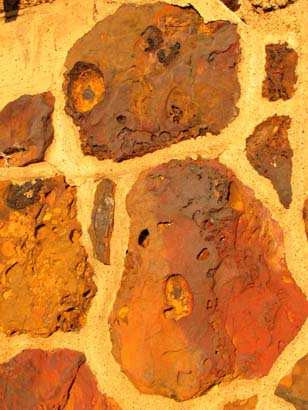 |
Due
to lack of sufficient records, there are almost no specific references
to be found which describe the original buildings on the property.
Interviews conducted in the mid 1980s offer brief descriptions of
the site, as told by J.B. Crutcher and Stanley Walton, both of which
were previous owners of the poor farm.
At the time of the interviews conducted with Crutcher and Walton a
collapsing potato barn was still on the property. The hand-hewn notched
log construction, with whitened clay used as mortar had seen better
days. High winds and extreme weather had taken their toll on the primitive
18x20 building. Inside the barn were a double tier of bins used to
store potatoes after they were harvested.
The structure used to house the county’s indigents was a long curving
row of rooms. The building was covered with native rocks. According
to Anderson County Historical Commission records, there were somewhere
between 10 and 14 rooms. A v-shaped lounging rooms was built on to
one end of the building, complete with a native rock chimney. Ruins
of the structure existed until the property was purchased by Crutcher,
who demolished the remains of the structure due to dangerous conditions.
In
1882, a jail was constructed on the property. The jail, which is still
standing today, was constructed as an adjoining building with the
structure used to house the indigents. According county records, convicts
that were housed at the poor farm worked on road crews and on the
farm to “work off” their sentences.
Today, the native rock exterior is separating from the reinforced
concrete walls of the old jail. One end of the 66’x13 ½ ‘ structure
was considered “minimum security.” The two minimum security rooms
were adjoined with the housing structure. In the corner of each room
is a slightly raised area and a drain. The drains are believed to
be for showers that were installed later. Also, each minimum security
room has a flue, which is presumed to have been for cooking and/or
heating. Both rooms of the minimum security area have barred windows,
and massive metal doors. |
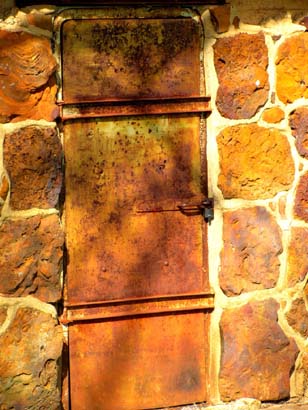 |
On the inside
of each metal door a set of rules was painted, which read:
At the sound of the bell make beds and sweep out.
Scrub commodes and lavatory.
Do not wash clothes under shower.
Flush commode immediately after use.
Take a shower each Wednesday night.
Help keep this place clean, and this means YOU.
These rules are thought to have been revised as time progressed.
The opposite end of the jail was considered maximum security. On this
end two cells containing two metal bunk beds each, one window a piece,
and one heavy metal lattice style doors. The heavy doors opened into
a small area that was separated from the outside by another heavy
metal door. The locking system for the maximum security area was intricate
and individual. There were places to lock each individual cell, the
holding area, the outside door, and there was also a master switch
that could be locked. Local legend suggests the heat must have been
almost unbearable, and was likely built in such a fashion as a deterrent
for bad behavior. |
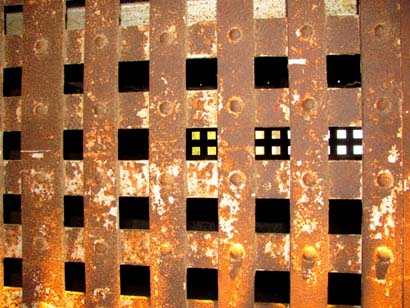 |
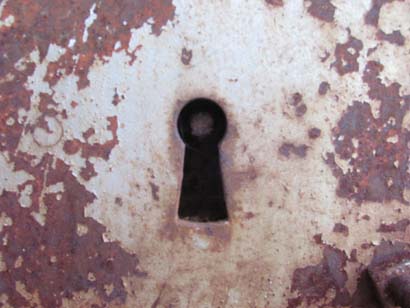 |
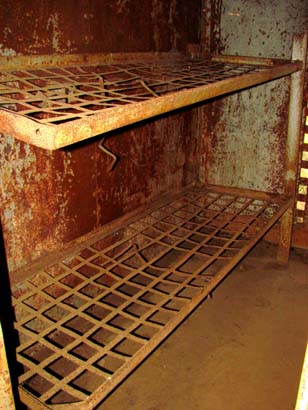 |
Farming conducted
on poor farms was primarily done in order to provide tenants with
food. Counties generally did not sell crops for profit, however, an
occasional cash for cotton venture did take place. Each poor farm
grew what was best suited for its land. Anderson
County grew cotton, potatoes
and corn. Hogs were also raised
on the Anderson County Poor Farm, and there was also a canning operation.
An estimated 75 to 100 pauper graves are also an area of interest
on the old Anderson County Poor Farm. The last marker for the many
graves was a lone metal funeral marker close to the southern edge
of the property. Since Anderson
County> records only reflect the cost of pauper burials, coffins,
burial clothes, and grave digging pauper names details are likely
lost forever.
Anderson, Parker,
and Cass counties
are unique for their written documentation. The Texas Historical Commission
surveyed county historical commissions for their poor farm information
and received fewer than five responses from 252 different commissions.
The
final chapter of the Anderson County Poor Farm began in 1957. The
Anderson County Commissioners Court minutes reported a final lease
through December 1958. In 1960 the poor farm went up for sale. Jewett
Kiser purchased the poor farm at an auction, and then sold it to Stanley
Walton in 1962. Walton sold the poor farm a month later to J.B. Crutcher.
The poor farm has remains in the Crutcher family today. Family members
have fond memories of time spent playing on the property as children.
“I spent a lot of time playing in that old jail. We would play cowboys
and bad guys,” said family member Mike Bishop.
Joe Crutcher also has fond memories of growing up on the farm, and
continues to make memories with his grandchildren.
“It has a lot of history, but we use it more for storage than anything
these days. It has also become more of a playhouse for grandchildren,”
Crutcher said.
Crutcher also said his family used the old jail as a storm shelter
for many years.
“My mom and dad used to head to the old jail when storm clouds blew
in. It was a fortress, so you didn’t have tow worry about it blowing
away,” Crutcher said.
Crutcher is in the process of planting coastal Bermuda grass on the
property, as it is still a functioning farm today.
Time has marched on and the winds of change have blown swiftly through
Anderson County.
The constantly fading history of the Texas’ poor farm system is inching
closer to non-existence and will soon live only in the memories of
those who choose to recall the early efforts to care for the poor.
© Dana
Goolsby
Originally
published in the Palestine Herald Press
"In
The Pines With Dana Goolsby"
May 1, 2011 Column |
|
|